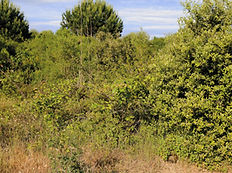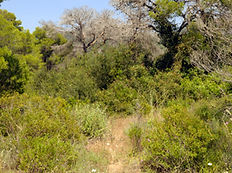
Die Macchia
Der von den Italienern als Macchie und von den Franzosen als Maquis bezeichnete Buschwald bestimmt heute weithin das Bild im gesamten Mittelmeerraum und ist zum natürlichen Lebensraum der meisten europäischen Landschildkröten geworden.

Seit Tausenden von Jahren ist der gesamte Mittelmeerraum von Kultivierung und Nutzung durch den Menschen geformt. Weite Teile des früher flächendeckenden Waldbewuchses wurden bereits in vorchristlicher Zeit unkontrolliert abgeholzt. Als Rest blieb die zwischen 1,5 und bis zu 10 Meter hoch werdende Macchia, welche heute als Sekundärvegetation ganze Landstriche flächendeckend überzieht.


Vom Meer breitet sich die Macchia auch in weiten Teilen landeinwärts in Täler und Hügelland bis etwa 1000 Meter aus.

Die dichten dornigen, stachelbewehrten und hartlaubigen Gebüsche verbreiten einen einzigartigen Duft, welcher von den als Verdunstungsschutz produzierten ätherischen Ölen und würzigen Harzen stammt.
Die Bäume und Büsche stehen teilweise so dicht, dass sie sich gegenseitig Platz und Licht streitig machen. Für uns Menschen ist die Macchia in weiten Teilen nicht begehbar, weshalb die Schildkröten dort ein noch ungestörtes Leben führen können.

Hauptsächlich Stein-(Quercus ilex) und Korkeiche(Quercus suber L.) aber auch kleinwüchsige Kiefern (Pinus ssp.), Terpentin-Pistazie (Pistacia terebinthus L.), Buchsbaum (Buxus sempervirens), wilder Ölbaum (Olea europaea L.), Johannisbrotbaum (Ceratonia siliqua L.) und Feigenbaum (Ficus carica L.) stehen, oft buschartig zusammen mit strauchigen großteils immergrünen ledrigderben Büschen wie Baumheide (Erica arborea L), Mastix (Pistacia lentiscus L.), Schmalblättrige Steinlinde (Phillyrea angustifolia), Myrten (Myrtus communis L), Erdbeerbaum (Arbutus unedo) und verschiedenen meist extrem stacheligen Sträuchern wie Stecheiche (Quercus coccifera L.), Dornginster(Calicotome villosa), Dornige Bibernelle (Sarcopoterium spinosum) oder Starre Stacheldolde (Echinophora spinosa L.), Heckenrose (Rosa ssp.) und Brombeere (Rubus ssp.).
Die Blätter dieser teilweise immergrünen Trockenheit ertragenden Sträucher und niederen Bäume (Xerophyten) sind klein und schmal, oft mit einer Wachsschicht oder mit Härchen überzogen oder zu Nadeln und Dornen entwickelt. Durch das Minimum an Fläche und dem wachsigen haarigen Überzug beugen die Pflanzen einem Wasserverlust durch übermässiges Verdunsten vor.



